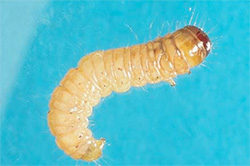ManageSafe
Least-Toxic Control of Tree-boring Caterpillars Choose a different pests

|
Factsheet: Least-toxic Control of Tree-boring Caterpillars
Identification
Pest type: Insects
Tree-boring caterpillars mature to become part of a group called clear-winged moths, which look similar to wasps. These moths lay eggs in late spring. When the resulting caterpillars hatch, they most often find an entry way into a tree through a wound, crack or graft scar.
Is it a problem?
Tree-boring caterpillars damage and stress a tree by feeding on the inner bark and cambium tree layer. A large enough population will kill the tree. Some trees targeted by various kinds of tree-boring caterpillars include flowering dogwoods, cherry trees, peach trees, almond trees, and rhododendrons.
Pest prevention practices
Since most wood-boring insects are considered secondary invaders, the first line of defense against infestation is to keep plants healthy. Proper care of trees and shrubs discourages many borer pests and helps infested plants survive. Good sap flow from healthy, vigorously growing trees, for example,defends the plant from damage by many borer pests. Some other good practices include:
Do not allow weeds to grow high along the base of the tree. Take care not to wound trees (i.e. with a lawn mower), as this provides a convenient entry point.
Remove and dispose all dead or dying branches that may be infested.
Plant trees and shrubs in appropriate locations. For example, dogwoods occur in nature as a forest understory and should not be planted in sunny locations
. Plant aspen, birch and eucalyptus in clusters. Wrap trunks of saplings with a specialized paper sold in nurseries. Tree-sealing may be used on tree wounds only on susceptible trees.
Do not overuse as this compound interferes with a tree’s ability to fight infection.
Monitoring and record-keeping
Tree-boring caterpillars maintain a hole outside the tree through which they expel sawdust and frass (fecel pellets). Resin, a clear gum produced by wounded trees, may indicate tree-boring caterpillars if it is mixed with frass and sawdust.
Non-chemical and mechanical controls
Kill larva by probing the hole with a long, flexible wire. This is effective if the tunnel in the tree is not overly long and twisted. Otherwise, control of tree borers is quite difficult, so disposing of infested wood is considered one of the best ways to eradicate the pest without the use of toxic chemicals.
Biological controls
The use of nematodes, tiny parasitic, insect-eating worms, is a non-chemical method proven effective. Use 20-30,000 nematodes per hole. Create a mixture of nematodes and water and place directly in the hole. The most effective method is soaking cotton strips in the solution and using tweezers to place as deeply in the hole as possible. You can also pour the mixture into a spray bottle and spray into the hole, although this is somewhat less effective.
Least-toxic chemical options as a last resort
If the opening on the tree is unobstructed, blow boric acid, diatomaceous earth or silica aerogel into it. Note that this method has never been experimentally tested.
Chemicals to Avoid
Look at your product labels and try to avoid products containing those chemicals listed below:
(A = acute health effects, C = chronic health effects, SW = surface water contaminant, GW = ground water contaminant, W = wildlife poison, B = bee poison, LT = long-range transport)
|
Abamectin/Avermectin B1 Acephate Bendiocarb Bifenthrin | Carbaryl Chlorpyrifos Cyfluthrin Dinotefuran | Endosulfan Imidacloprid Lindane | Permethrin Spinosad |








